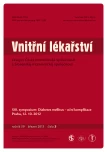Present and future of insulin treatment
Authors:
J. Škrha
Authors‘ workplace:
III. interní klinika 1. lékařské fakulty UK a VFN Praha, přednosta prof. MUDr. Štěpán Svačina, DrSc., MBA
Published in:
Vnitř Lék 2013; 59(3): 209-213
Category:
Reviews
Moderní léčba inzulinem není revoluce, ale evoluce. Clifton J. Bailey, 2012
Overview
The main goal of modern insulin treatment is to bring diabetes control to physiological regulation as close as possible. We move from human insulin to insulin analogues which may due to their properties reduce glucose excursions (glucose variability) with hypoglycemic and hyperglycemic episodes. Besides short acting insulin analogues diminishing extension of hyperinsulinemia and postprandial hypoglycemia observed by human insulin treatment, the long-acting analogues are used to create stabilized insulin level and to prevent nocturnal hypoglycemia. Individualized insulin treatment is the basement for modern trends in diabetology.
Key words:
human insulin – insulin analogues – individualized therapy
Sources
1. Polak JF, Backlund JYC, Cleary PA et al. Progression of Carotid Artery Intima-Media Thickness During 12 Years in the Diabetes Control and Complications Trial/Epidemiology of Diabetes Interventions and Complications (DCCT/EDIC) Study. Diabetes 2011; 60: 607–613.
2. White NH, Sun WJ, Cleary PA et al. Effect of Prior Intensive Therapy in Type 1 Diabetes on 10-Year Progression of Retinopathy in the DCCT/EDIC: Comparison of Adults and Adolescents. Diabetes 2010; 59: 1244–1253.
3. Ceriello A. The emerging challenge in diabetes: The “metabolic memory”. Vascular Pharmacology 2012; 57: 133–138.
4. Brazeau AS, Mircescu H, Desjardins K et al. Carbohydrate counting accuracy and blood glucose variability in adults with type 1 diabetes. Diabetes Research Clinical Practice 2013; 99: 19–23.
5. Evans M, Schumm-Draeger PM, Vora J et al. A review of modern insulin analogue pharmacokinetic and pharmacodynamic profiles in type 2 diabetes: improvements and limitations. Diabetes Obesity Metabolism 2011; 13: 677–684.
6. Donner T, Munoz M. Update on Insulin Therapy for Type 2 Diabetes. J Clin Endocrinol Metab 2012; 97: 1405–1413.
7. Keating GM. Insulin Detemir. A Review of its Use in the Management of Diabetes Mellitus. Drugs 2012; 72: 2255–2287.
8. Pirags V, El Damassy H, Dabrowski M et al. Low risk of severe hypoglycaemia in patients with type 2 diabetes mellitus starting insulin therapy with premixed insulin analogues BID in outpatient settings. Int J Clin Pract 2012; 66: 1033–1041.
9. Hompesch M, Muchmore DB, Morrow L et al. Improved Postprandial Glycemic Control in Patients with Type 2 Diabetes from Subcutaneous Injection of Insulin Lispro with Hyaluronidase. Diabetes Technol Therapeut 2012; 14: 218–224.
10. Heinemann L. New ways of insulin delivery. Int J Clin Pract 2011; 65: (Suppl. 170) :31–46.
11. Home PD, Meneghini L, Wendisch U et al. Improved health status with insulin degludec compared with insulin glargine in people with Type 1 diabetes. Diabetic Medicine 2012; 29: 716–720.
12. Garber AJ, King AB, Del Prato S et al. Insulin degludec, an ultra-longlasting basal insulin, versus insulin glargine in basal-bolus treatment with mealtime insulin aspart in type 2 diabetes (BEGIN Basal-Bolus Type 2): a phase 3, randomised, open-label, treat-to-target non-inferiority trial. Lancet 2012; 379: 1498–1507.
13. Bergenstal RM, Rosenstock J, Arakaki RF et al. A Randomized, Controlled Study of Once-Daily LY2605541, a Novel Long-Acting Basal Insulin, Versus Insulin Glargine in Basal Insulin-Treated Patients With Type 2 Diabetes. Diabetes Care 2012; 35: 2140–2147.
14. Gonzales C, Maury E, Barcos I et al. Can Continuous Glucose Monitoring Systems Predict Glycemia? Diabetes Technology & Therapeutics 2012; 14: 1030–1032.
15. Yang J, Sun H, Song C. Preparation, characterization and in vivo evaluation of pH-sensitive oral insulin-loaded poly(lactic-co-glycolicacid) nanoparticles. Diabetes Obesity & Metabolism 2012; 14: 358–364.
16. Elleri D, Allen JM, Biagioni M et al. Evaluation of a portable ambulatory prototype for automated overnight closed-loop insulin delivery in young people with type 1 diabetes. Pediatric Diabetes 2012; 13: 449–453.
Labels
Diabetology Endocrinology Internal medicineArticle was published in
Internal Medicine

2013 Issue 3
Most read in this issue
- Diabetic nephropathy/diabetic kidney disease
- Treatment of diabetic macular oedema
- Progression of diabetic retinopathy in pregnancy
- Patophysiology of diabetic retinopathy
